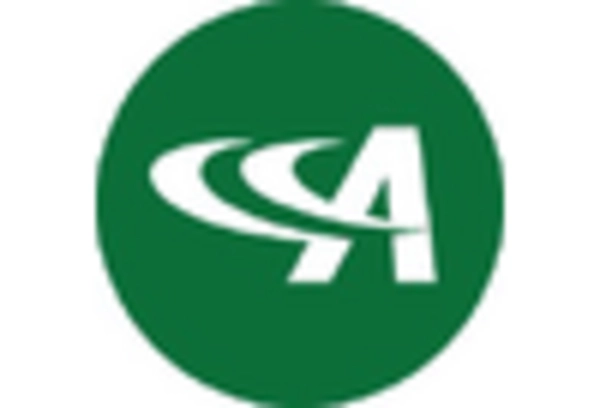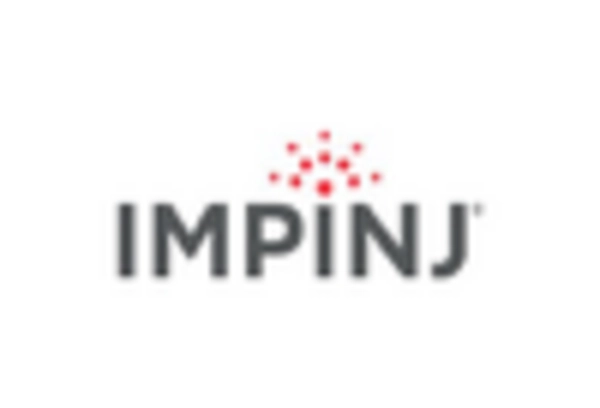Rising Demand for Asset Tracking
The increasing need for efficient asset management is a key driver in the real time-locating-systems market. Organizations in India are recognizing the importance of tracking assets in real-time to minimize losses and enhance operational efficiency. Industries such as manufacturing, healthcare, and logistics are particularly focused on implementing RTLS solutions to monitor the location and status of critical assets. According to recent estimates, the asset tracking segment is projected to account for over 40% of the overall market share by 2026. This growing demand is fueled by the need for improved inventory management and the reduction of operational costs. As businesses strive for greater transparency and accountability, the adoption of RTLS for asset tracking is likely to accelerate, further propelling the growth of the real time-locating-systems market.
Government Initiatives and Support
Government initiatives aimed at enhancing infrastructure and technology adoption are significantly influencing the real time-locating-systems market. In India, various policies and programs are being introduced to promote smart technologies across sectors. The Digital India initiative, for instance, encourages the integration of advanced technologies in public services and urban planning. Such initiatives are expected to create a conducive environment for the deployment of RTLS solutions, particularly in sectors like transportation and public safety. Furthermore, government funding and support for research and development in this domain may lead to innovative applications of RTLS, thereby expanding its market potential. As these initiatives gain momentum, they are likely to stimulate growth in the real time-locating-systems market, fostering collaboration between public and private sectors.
Technological Advancements in RTLS
The rapid evolution of technology plays a pivotal role in the market. Innovations in wireless communication, such as Bluetooth Low Energy (BLE) and Ultra-Wideband (UWB), enhance the accuracy and efficiency of locating systems. In India, the integration of Internet of Things (IoT) devices with RTLS is becoming increasingly prevalent, allowing for real-time data collection and analysis. This technological synergy is expected to drive market growth, with projections indicating a CAGR of approximately 20% over the next five years. Furthermore, advancements in artificial intelligence and machine learning are likely to improve the predictive capabilities of RTLS, making them more appealing to various sectors, including logistics and manufacturing. As these technologies continue to mature, they are expected to significantly impact the real time-locating-systems market, fostering greater adoption across industries.
Expansion of E-commerce and Logistics
The rapid expansion of e-commerce in India is significantly impacting the real time-locating-systems market. As online shopping continues to grow, logistics and supply chain management have become increasingly complex. Companies are seeking efficient solutions to manage inventory and track shipments in real-time. The integration of RTLS in logistics operations allows for improved visibility and control over the supply chain, which is crucial for meeting customer expectations. Recent data indicates that the logistics sector is projected to grow at a CAGR of 10% through 2027, further driving the demand for RTLS solutions. This growth is likely to enhance operational efficiency and reduce delivery times, making RTLS an essential component in the evolving landscape of e-commerce and logistics. Consequently, the real time-locating-systems market is expected to benefit from this trend, as businesses strive to optimize their operations.
Increased Focus on Safety and Security
The heightened emphasis on safety and security in various sectors is driving the demand for real time-locating-systems. In India, organizations are increasingly adopting RTLS to enhance workplace safety, particularly in industries such as construction and manufacturing. By enabling real-time monitoring of personnel and equipment, RTLS can help mitigate risks and ensure compliance with safety regulations. Additionally, the growing concern over security threats has prompted businesses to implement RTLS for tracking assets and personnel in sensitive environments. This trend is expected to contribute to a robust growth trajectory for the real time-locating-systems market, with estimates suggesting a potential increase in market size by 15% over the next few years. As safety and security remain paramount, the adoption of RTLS solutions is likely to become more widespread across various industries.

















Leave a Comment